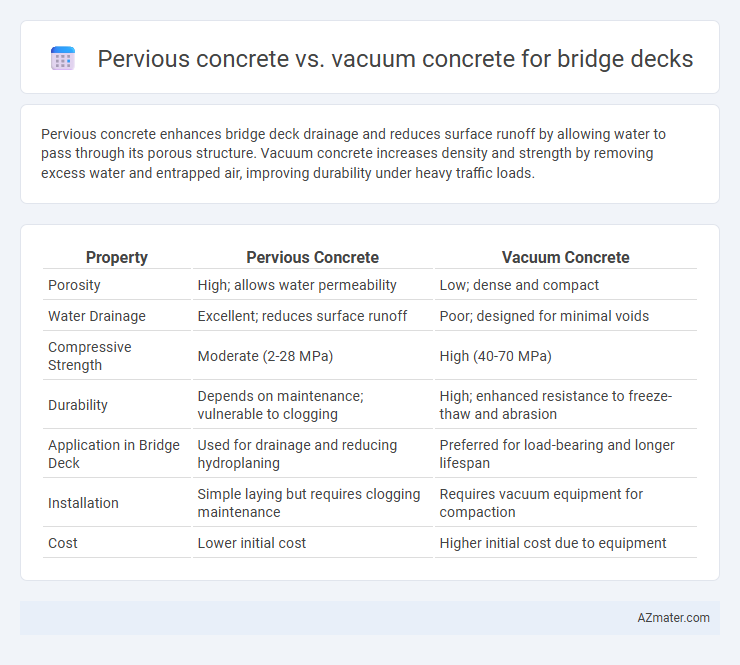Pervious concrete enhances bridge deck drainage and reduces surface runoff by allowing water to pass through its porous structure. Vacuum concrete increases density and strength by removing excess water and entrapped air, improving durability under heavy traffic loads.
Table of Comparison
| Property | Pervious Concrete | Vacuum Concrete |
|---|---|---|
| Porosity | High; allows water permeability | Low; dense and compact |
| Water Drainage | Excellent; reduces surface runoff | Poor; designed for minimal voids |
| Compressive Strength | Moderate (2-28 MPa) | High (40-70 MPa) |
| Durability | Depends on maintenance; vulnerable to clogging | High; enhanced resistance to freeze-thaw and abrasion |
| Application in Bridge Deck | Used for drainage and reducing hydroplaning | Preferred for load-bearing and longer lifespan |
| Installation | Simple laying but requires clogging maintenance | Requires vacuum equipment for compaction |
| Cost | Lower initial cost | Higher initial cost due to equipment |
Introduction to Bridge Deck Concrete Technologies
Pervious concrete and vacuum concrete represent advanced bridge deck concrete technologies designed to enhance durability and water management. Pervious concrete features high permeability to reduce surface runoff and mitigate hydroplaning risks, improving safety and extending deck lifespan. Vacuum concrete utilizes vacuum pressure to remove excess water and entrapped air, resulting in higher density and strength, which is critical for bridge deck performance under heavy traffic loads.
What is Pervious Concrete?
Pervious concrete is a specialized concrete mix designed to allow water to pass through its porous structure, effectively reducing surface runoff and promoting groundwater recharge. This permeability makes it an ideal choice for bridge decks requiring efficient drainage to prevent water accumulation and related damage. Compared to vacuum concrete, which uses vacuum pressure to remove excess water for increased strength and density, pervious concrete prioritizes permeability and environmental benefits on bridge surfaces.
What is Vacuum Concrete?
Vacuum concrete is a specialized type of concrete used for bridge decks that involves applying a vacuum to the freshly placed concrete surface to extract excess water, resulting in a denser and stronger material. This process enhances the concrete's durability, reduces permeability, and improves resistance to freeze-thaw cycles, making it ideal for high-performance bridge applications. Compared to pervious concrete, which is designed to allow water infiltration, vacuum concrete prioritizes strength and longevity by minimizing moisture retention.
Key Differences Between Pervious and Vacuum Concrete
Pervious concrete for bridge decks emphasizes high permeability and water drainage, reducing runoff and promoting groundwater recharge, whereas vacuum concrete enhances strength and durability by removing excess water through vacuum-assisted compaction. Pervious concrete features interconnected voids for permeability around 15-25%, while vacuum concrete achieves higher density and compressive strength, often exceeding 40 MPa. Maintenance requirements differ significantly: pervious concrete demands regular clearing of clogged pores, while vacuum concrete focuses on long-term structural resilience and reduced shrinkage cracks.
Strength and Durability: A Comparative Analysis
Pervious concrete for bridge decks offers enhanced permeability, reducing hydrostatic pressure and improving freeze-thaw resistance, while vacuum concrete achieves higher compressive strength through improved particle packing and reduced porosity. Vacuum concrete typically demonstrates superior durability against abrasion and chemical attack, making it suitable for heavy traffic loads and harsh environments, whereas pervious concrete provides effective drainage but may require more maintenance due to potential clogging. Comparative studies indicate that vacuum concrete's density and strength characteristics generally surpass pervious concrete in structural performance, though pervious concrete contributes significantly to sustainable water management in bridge applications.
Water Permeability and Drainage Performance
Pervious concrete offers superior water permeability and drainage performance for bridge decks by allowing water to pass through its porous structure, effectively reducing surface runoff and preventing hydroplaning. Vacuum concrete, while having lower permeability, provides enhanced strength and durability but requires additional drainage systems to manage water accumulation efficiently. Optimal bridge deck design balances the permeability of pervious concrete with the structural benefits of vacuum concrete to ensure both effective drainage and long-term performance.
Installation Processes and Construction Time
Pervious concrete for bridge decks involves a straightforward installation process with limited curing time, allowing for quicker water drainage and reduced surface runoff. Vacuum concrete requires a more complex installation that includes the use of vacuum suction equipment to remove excess water, which extends construction time but enhances concrete density and durability. While pervious concrete shortens overall project timelines due to faster setting and less labor-intensive methods, vacuum concrete delivers longer-lasting strength at the cost of increased installation duration.
Cost Analysis: Pervious vs Vacuum Concrete
Pervious concrete generally offers lower initial costs compared to vacuum concrete due to simpler production and placement methods, reducing labor and equipment expenses. Vacuum concrete entails higher upfront investments driven by specialized vacuum equipment and increased curing time, which can raise project durations and associated costs. Lifecycle cost analysis often favors pervious concrete for its cost-effectiveness in managing stormwater and minimizing maintenance on bridge decks without compromising durability.
Sustainability and Environmental Impact
Pervious concrete enhances sustainability in bridge decks by promoting stormwater infiltration, reducing runoff, and improving groundwater recharge, thereby mitigating urban heat island effects and decreasing pollution. Vacuum concrete, although offering higher strength and durability, requires more energy-intensive production processes, potentially increasing its environmental footprint compared to pervious concrete. The selection of pervious concrete supports eco-friendly infrastructure by balancing structural performance with significant environmental benefits through natural water management.
Best Applications for Each Concrete Type in Bridge Decks
Pervious concrete is ideal for bridge decks requiring enhanced stormwater management and rapid drainage to reduce surface water accumulation and improve safety. Vacuum concrete offers superior strength and durability, making it best suited for high-load bridge decks exposed to heavy traffic and harsh environmental conditions. Selecting between the two depends on balancing permeability needs with structural performance demands specific to the bridge design.

Infographic: Pervious concrete vs Vacuum concrete for Bridge deck
 azmater.com
azmater.com